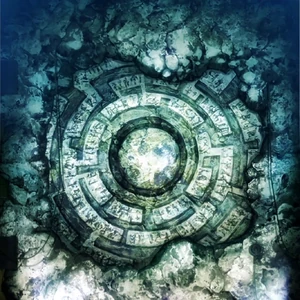| Dresden Slate | |
|---|---|

| |
| Name | |
| Kanji | ドレスデン石盤 |
| Rōmaji | Doresuden Sekiban |
| Information | |
| User | Klaudia Weismann Adolf K. Weismann Daikaku Kokujōji Reisi Munakata Nagare Hisui Anna Kushina |
| First appearance | |
| Anime Debut | Episode 3 (mentioned) Episode 9 |
The Dresden Slate is a mysterious stone that is the source of the Auras and various Swords of Damocles used by the Kings.
The power of the Slate could manifest not only in humans but in animals as well. Under the control of Daikaku Kokujōji, its range was limited to only the Kanto region.[1] However, as Nagare Hisui unleashed the Dresden Slate's full potential, its influence extended to a global level.[2] Yashiro Isana destroyed it with a Damocles Down.[3]
Appearance[]
The Dresden Slate is a huge, rectangular stone, heavy enough that it required special attachments when transferred from Dresden to Nanakamado. At its center is a circular design similar to a maze. It's noted the Slate emits a blueish-green glow at times. Engraved into the Slate is the term "Rex", meaning "King" in Latin, along with many other engravings. This led to it being regarded as a "natural" entity. To further prove this point, the Slate often appears "alive" to those near it, giving off a sort of stirring atmosphere.[4]
In "K: Seven Stories", the Slate appears as a small child. Created from a single wish by Sukuna Gojo after the Slate's destruction, the boy represents a broken fragment of the destroyed Dresden Slate; an "afterglow". As a human figure, "he" has long, white-blond hair and blue/green, glass-like eyes. The Slate serves as the narrator throughout "Seven Stories", and later creates a dream-like world where the characters may see their lost loved-ones for one last time. [5]

The Slate as a small child.
History[]
A legend claims that the Dresden Slate was brought to St. John's Church from Bohemia, and initially regarded as a holy artifact. It remained underground for a number of years until 1941, when rumour of a praying believer claimed to witness a "miracle". Eventually, the Schutzstaffel (SS)'s Ahnenerbe took interest in this claim, and thus dug up the Slate and took it into their custody, hoping that they would be able to prove Aryan superiority through archaeological studies of the Slate's true nature. All religious importance surrounding the Slate, for the most part, was lost, and it simply became an object of interest to them instead.[6]
In 1943, guards witnessed the "miracle" the believer spoke of: flies surrounding the Slate and glowing bright red despite the excavation site's minimal lighting, until the light and flies burnt away. The phenomena became known as the Procession of St. John, and the flies' remains were brought up for observation and research. To further advocate the Slate's research, the SS intended to show the Reichsführer-SS its "miracle", hoping it could somehow assist them in turning the tables of World War II over to their favour. After raising a large amount of capital and human resources, the underground area was completely reconstructed as an underground research facility with the most cutting-edge technology of the time, and recruited the most brilliant minds of the time to the project.[4]
Specific members included the director and deputy director, Adolf K. Weismann and Klaudia Weismann respectively. The process of their selection is unknown, but the two made vast accomplishments in scientific fields in the past, referred to as geniuses. Much opposition to their selected fields stirred from others wanting their participation, but ultimately the Reichsführer-SS's was finalised and the Weismann siblings' position established. Regardless of their prowess, neither siblings was well off on their own given a bias against their intellect and Klaudia's general status as a woman involved in such a project.[6]
Dealing with the Slate proved a difficult task supernaturally, thus the help of Japanese onmyōji was later enlisted, the core of them being Daikaku Kokujōji[6]. To unseal the Slate's power, it was necessary to upset a specific cycle within the seal that incorporated the Five Elements. In a loosely scientific sense, the Slate's mechanism had been forcefully stopped, and needed to be triggered in order for its true potential to be at the forefront as a war tool, however it's noted that the Slate, even when sealed, still had enough power to affect small organisms such as the flies. For Weismann and Klaudia, this meant that if the W Deviation Transposer could operate properly, then the Slate's seal could be controlled safely without bringing anyone to risk during research and experimentation.
The Latin "rex", "king", engraved into the stone led Weismann to believe the Slate had relevance to his convergence theory and that the Slate would, somehow, "link" to the bodies of others and their lives. The engraving also prompted the project's name - König Project.
After the Dresden Bombing of 1945, Kokujōji and later Timeless Palace took complete custody of the Slate, manipulating the seal on it to keep its influence solely within Japan's Kanto region; the government sees the Slate as a valuable treasure, according to the Prime Minister. Although the research facility in Dresden had been destroyed, Klaudia's copies of documents related to its research were found, preserved, and kept in a library.[7]
Influence[]
The Dresden Slate, according to Weismann's theory, affects organisms based on their mental complexity and quantitative value. That being that more complex individuals would have greater grasps of the Slate's power, and were able to pass on lesser amounts of that power onto others. How specific colours get assigned to specific people is not clearly known, but Weismann also theorised that specific, consistent variables within individuals made them eligible for the Slate's choosing them as Kings and which position they uphold as a King.[1]
Unrelated to Weismann's research is the influence the Slate appears to have on Strains. It is presumed that Strains are "failed" Kings, not entirely eligible to become Kings but still strongly affected by its power, however others presume it to be a mere "leakage" of the Slate's power affecting individuals regardless of their eligibility of Kingship, however Strains are capable of becoming Kings.[8]
Custody[]
The Gold King and his Clan, for many years, held custody over the Slate, thus making Kokujōji the most powerful King, as he was the one regulating and limiting the Slate's influence. Although he controlled its range and general influence on the population, it's most likely he had no influence in who the Slate chose to become a King. How the Slate's Auras have been channeled into separate pods within its chamber is unknown.
After Kokujōji's passing, Reisi Munakata and Scepter 4 obtained legal custody of the Slate, with Munakata attempting to make the Slate obey and respond to him.[7]
Unfortunately, circumstances came to an ugly turn of events as the Green Clan successfully penetrated Mihashira Tower and made away with the Dresden Slate.[9] The Slate is left to emanate its power uncontrollably, as intended by the Green King for a revolution of dynamics. As a result, normal civilians are capable of acquiring Auras without being a Clansman or a Strain, provoking chaos around the city and, later, globally.[2][10] It is later destroyed, by the Silver King, who used a Damocles Down with his own Sword of Damocles to end the Dresden Slate's influence in the world.[3]
References[]
- ↑ 1.0 1.1 K Anime: Episode 9
- ↑ 2.0 2.1 K Return of Kings, episode 9
- ↑ 3.0 3.1 K Return of Kings, episode 13
- ↑ 4.0 4.1 K SIDE:Black & White, chapter 3, "O'er the East and West"
- ↑ K: Seven Stories (Circle Vision- "Nameless Song") movie 6
- ↑ 6.0 6.1 6.2 Christmas 1944 by GoRA Black
- ↑ 7.0 7.1 K Return of Kings, episode 5
- ↑ K SIDE:RED, chapter 1
- ↑ K Return of Kings, episode 8
- ↑ K Return of Kings, episode 12